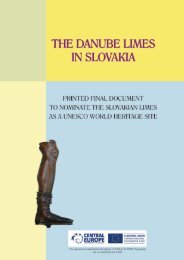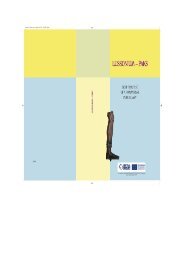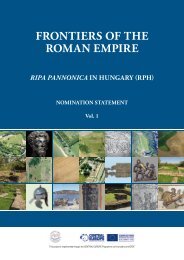DEFiNitiON, DEScRiPtiON ANd MAPPiNG OF ... - Danube Limes
DEFiNitiON, DEScRiPtiON ANd MAPPiNG OF ... - Danube Limes
DEFiNitiON, DEScRiPtiON ANd MAPPiNG OF ... - Danube Limes
Erfolgreiche ePaper selbst erstellen
Machen Sie aus Ihren PDF Publikationen ein blätterbares Flipbook mit unserer einzigartigen Google optimierten e-Paper Software.
14. Szentendre – Római tábor<br />
KÖH id. nr.: 11521<br />
Ulcisia<br />
Lajos Nagy and then Tibor Nagy<br />
performed excavations in 1934-35, and then in<br />
1939-40 and 1942 on this archaeological site<br />
that was known of in the Middle Ages and<br />
Modern era. After Sándor Soproni and Márta<br />
H. Kelemen’s rescue excavations, the<br />
investigations into the fort resumed under the<br />
direction of Éva Maróti in 2001.<br />
The fort had a ground area of 205×134 m.<br />
During the first phase there were recessed<br />
towers, and then these were replaced by Ushaped<br />
wall towers and fan-shaped corner<br />
towers. In addition to the praetorium building we<br />
know details from two other interior buildings.<br />
It was surrounded by a double ditch, and of its<br />
four gateways, presumably three of them were<br />
walled off with horseshoe shaped towers in the<br />
later period.<br />
There was probably a period when a camp<br />
was constructed from palisades, and on the<br />
basis of the earlier finds that have been<br />
discovered this may have been erected in the 1 st<br />
century. The first stone fort may have been<br />
built during the reigns of Trajan and Hadrian<br />
(98-138), and this was rebuilt after the<br />
Marcomannic Wars (180). The horseshoe<br />
shaped wall towers and fan shaped corner<br />
towers may have been constructed sometime<br />
after 270 or during the time of Constantine<br />
(306-337). The gateways may have been walled<br />
off during the reign of Valentinian (364-375).<br />
The fort was probably still being used even in<br />
the 5 th century.<br />
The walls of the fort have not been<br />
covered over again since the most recent<br />
excavations, and the Ferenczy Museum in<br />
Szentendre is planning their exhibition, but the<br />
historic rehabilitation has not begun yet.<br />
Boundaries of core and buffer zones:<br />
The core zone is the presently known extent of<br />
the camp, including and extending along the<br />
borders of the properties encompassing the<br />
ditches. It only differs from the property<br />
boundaries at the roads. The border of the<br />
buffer zone to the east and west supplements<br />
the core zone up to the property boundaries of<br />
40<br />
the present day roads. We do not know of the<br />
extent of the settlement that developed around<br />
the fort. It may have been to the south of the<br />
fort for the most part, and therefore the<br />
designation of the buffer zone was not<br />
determined by it.<br />
Bibliography:<br />
NAGY T. 1942, 261-285.<br />
SOPRONI 1978, 68-71.<br />
TÓTH 2006, 27-31.<br />
33. The southern gateway covered by temporary winter<br />
protection (Photo: Gábor Rákóczi)<br />
34. The most recent excavations brought the fort’s<br />
western side to the surface once again<br />
(Photo: Gábor Rákóczi)<br />
35. The ground plan of the fort (Digitalization: PTE)











